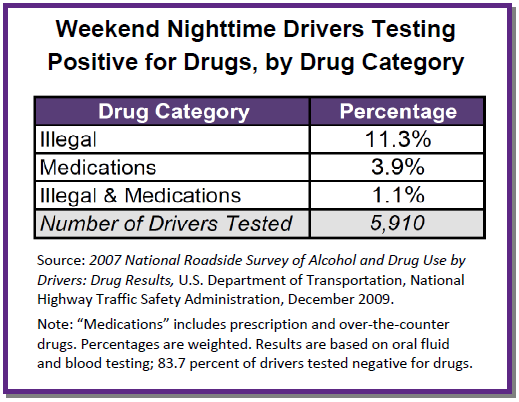Working to Get Drugged Drivers off the Road
Americans are all-too familiar with the terrible consequences of drunk driving. We also are becoming increasingly aware of the dangers of driving with distractions such as text messaging or talking on a cell phone. Working with the Department of Transportation (DOT) and other Federal agencies, the Office of National Drug Control Policy (ONDCP) is taking steps to highlight the growing problem of drugged driving.
Drugged driving poses threats to public safety, as evidenced by the number of fatal crashes each year on our Nation’s highways. Law enforcement officials see the tragedies that too often result when people take drugs and drive. Fortunately, trained Drug Recognition Experts can help to identify drugged drivers, hold them accountable, and get them off the road and into treatment.
see the tragedies that too often result when people take drugs and drive. Fortunately, trained Drug Recognition Experts can help to identify drugged drivers, hold them accountable, and get them off the road and into treatment.
It is well known that drugs, even those prescribed by a physician, can impair perception, judgment, motor skills, and memory. Recent surveys have shown how pervasive drugged driving has become in the United States.
The National Roadside Survey of Alcohol and Drug Use by Drivers, a nationally representative survey by the National Highway Traffic Safety Administration (NHTSA), found that in 2007, one in eight weekend nighttime drivers tested positive for illegal drugs. Moreover, approximately one in ten high school seniors responding to the 2008 Monitoring the Future Study (MTF) reported that in the two weeks prior to the survey interview they had driven after smoking marijuana.
The most compelling evidence of the severity of the drugged driving threat was provided in data released by NHTSA in November 2010. According to the Fatality Analysis Reporting System (FARS), one in three (33 percent) of all drivers with known drug-test results who were killed in motor vehicle crashes in 2009 tested positive for drugs (illegal substances as well as over-thecounter and prescription medications). Even as the total number of drivers killed in motor vehicle crashes declined 21 percent from 2005 to 2009, the involvement of drugs in fatal crashes increased by 5 percent over the same time period. Drug involvement means drugs were found in the driver’s system and does not imply impairment or indicate that drug use was the cause of the crash. However, research shows that drugs have adverse effects on judgment, reaction time, motor skills, and memory – critical skills for safe and responsible driving.
The roadside report can be found online at www.nhtsa.dot.gov. In FY 2012, NHTSA will continue to measure the prevalence of drug use by drivers and work to better document the increased risk of crash involvement due to drug use by drivers. This will involve work on a new national roadside survey and the analysis of data collected during the case-control study to determine the crash risk associated with driving under the influence of some drugs (those used by a large percentage of the driving population) and alcohol.
Monitoring the Future is available online at www.monitoringthefuture.org. More information about FARS can be found at http://www.nhtsa.gov/FARS.
Addressing the Public Safety Threat
Successful substance-abuse prevention programs, combined with public education and penalties for those who fail to comply with the law, will continue to receive support in the effort to reduce the public safety threat of drugged driving.
These include two DOT initiatives:
- Over the Limit. Under Arrest – an effort to crack down on impaired driving.
- The Drug Evaluation and Classification (DEC) Program, which aids state and local jurisdictions in detecting and arresting drugged drivers. The DEC program also provides training to prosecutors and judges in the prosecution of drugged drivers.
More information about these programs can be found online at http://www.nhtsa.dot.gov.
Federal Prevention Programs
Other Federal programs focus on drug abuse prevention, such as the National Youth Anti-Drug Media Campaign, which offers free online resources to help prevent drugged, drunk, and distracted driving among teenagers, and the Drug Free Communities Support program, which helps communities identify and respond to local substance abuse problems.
Web sites:
- National Youth Anti-Drug Media Campaign: http://www.mediacampaign.org/faqs.html
- Drug Free Communities Support Program: http://www.ondcp.gov/dfc/overview.html
Seeking Local Solutions
Much more can be done at the State and local levels:
- States can explore legal responses, such as per se laws that make it illegal for individuals to drive with illicit drugs in their system. This not only will keep drugged drivers off the road, it will hold them accountable and encourage them to get treatment so they can lead a drug-free life.
- Doctors can help by learning to recognize patients with substance-use problems and by talking to patients about such issues.
- Parents can talk to their children about the consequences of alcohol and illicit drug use.
- Communities can reinforce the message that alcohol and drug abuse can cause serious harm.
- Individuals who abuse drugs can seek help and choose to live a drug-free life.
Download PDF
